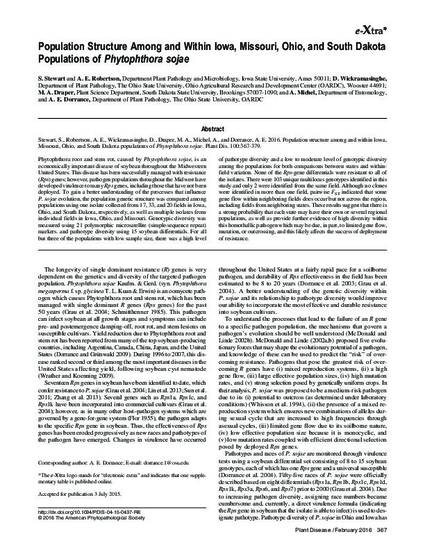
Phytophthora root and stem rot, caused by Phytophthora sojae, is an economically important disease of soybean throughout the Midwestern United States. This disease has been successfully managed with resistance (Rps) genes; however, pathogen populations throughout the Midwest have developed virulence to many Rps genes, including those that have not been deployed. To gain a better understanding of the processes that influence P. sojae evolution, the population genetic structure was compared among populations using one isolate collected from 17, 33, and 20 fields in Iowa, Ohio, and South Dakota, respectively, as well as multiple isolates from individual fields in Iowa, Ohio, and Missouri. Genotypic diversity was measured using 21 polymorphic microsatellite (simple-sequence repeat) markers. and pathotype diversity using 15 soybean differentials. For all but three of the populations with low sample size, there was a high level of pathotype diversity and a low to moderate level of genotypic diversity among the populations for both comparisons between states and within-field variation. None of the Rps-gene differentials were resistant to all of the isolates. There were 103 unique multilocus genotypes identified in this study and only 2 were identified from the same field. Although no clones were identified in more than one field, pairwise FST indicated that some gene flow within neighboring fields does occur but not across the region, including fields from neighboring states. These results suggest that there is a strong probability that each state may have their own or several regional populations, as well as provide further evidence of high diversity within this homothallic pathogen which may be due, in part, to limited gene flow, mutation, or outcrossing, and this likely affects the success of deployment of resistance.
Available at: http://works.bepress.com/alison-robertson/246/

This artilcle is published as Stewart, S., Robertson, A. E., Wickramasinghe, D., Draper, M. A., Michel, A., and Dorrance, A. E. 2016. Population structure among and within Iowa, Missouri, Ohio, and South Dakota populations of Phytophthora sojae. Plant Dis. 100:367-379. doi: 10.1094/PDIS-04-15-0437-RE. Posted with permission.